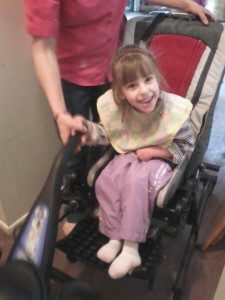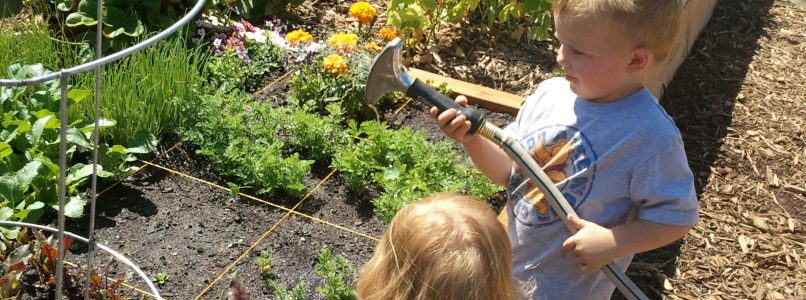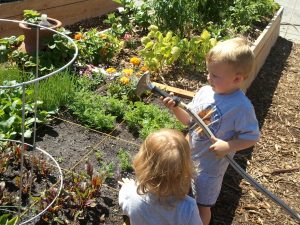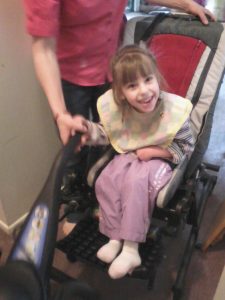 Four of the finest clowns
Four of the finest clowns
in our fair city!
The Circus is in town!! Back in the 50s, that news brought a shiver to my spine and a smile to my face. I loved going to the circus. It was held outside in a large tent every year. There were elephants, trapeze artists, and lions being tamed. Everything smelled of sawdust, cotton candy, peanuts, and candied apples. It was an exciting event!
As I grew older, the circus changed. Long gone was the tent, replaced by huge arenas in large buildings. They seemed to come around less often. Children didn’t know as much about them, and they weren’t a yearly, long-awaited event that the whole town looked forward to.
I didn’t think any grandchildren I lived near had ever been to a circus. WOW! At the library, I found a couple of books and decided we would study circuses and then have one of our own.
What happens at a circus?
Who comes, who performs, do you eat anything, what in the world is a clown? These were questions we were going to answer in grandma school.
When I arrived at my grandchildren’s home (before we began sharing the same living space), Mary, who was 2, reached me first. That was usually the case because she loves immersive learning. She wanted to know what was in my orange basket! She delighted in pulling everything out. She found large glasses, boas, bow ties, and makeup. She was excited about all of it, but the boas. Mary was afraid of the feathers. (Years later, we got chickens, and she was the one who could catch them. Her fear of feathers was gone.)
Keep your materials simple
We began the day by looking at pictures of clowns and talking about who they are and what they do. They are funny, do tricks, and like to make people laugh. We decided to be clowns for the day. Out came the white face paint and lipstick. The white face paint was Halloween makeup I bought many years ago. It worked well enough. For red, we used what grandma had, lipstick. As I say, keep it simple. Then we tried on all the glasses, boas, ties, and other costume items. Jack fell in love with a hat and a bow tie. He asked me if he could have them. I said he could surely borrow them. “I don’t like borrow” he said, “I want to have them!” LOL
white face paint and lipstick. The white face paint was Halloween makeup I bought many years ago. It worked well enough. For red, we used what grandma had, lipstick. As I say, keep it simple. Then we tried on all the glasses, boas, ties, and other costume items. Jack fell in love with a hat and a bow tie. He asked me if he could have them. I said he could surely borrow them. “I don’t like borrow” he said, “I want to have them!” LOL
I hadn’t found many books about the circus at our small library, so I ordered some from other libraries. I never got them picked up before our circus day. That’s how it is in real life, sometimes we are on it and 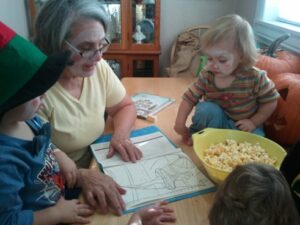 sometimes we aren’t! We managed with what we had, and I made a circus book. I found a terrific site of circus pictures, printed them off, and put them into a binder. (Jack, Mary, and Maggie used it until it fell apart.) It also made a great circus coloring book.
sometimes we aren’t! We managed with what we had, and I made a circus book. I found a terrific site of circus pictures, printed them off, and put them into a binder. (Jack, Mary, and Maggie used it until it fell apart.) It also made a great circus coloring book.
We looked at the pictures and discussed what was happening in each one, and if we would like to do that trick.
What We Did in Our Circus
1. Did you know that in some circus acts, they have dogs that dress up and do tricks? Well, Maggie,  Jack, and Mary have a dog. We dressed him up to see if he could do a trick. He did! He peed on the floor from fright. We let him go and went on with our circus without him. It’s a good thing we still had clowns, us. : )
Jack, and Mary have a dog. We dressed him up to see if he could do a trick. He did! He peed on the floor from fright. We let him go and went on with our circus without him. It’s a good thing we still had clowns, us. : )
2. We decided to walk a tightrope. We used a rake handle for our tightrope. (The rake head helped the stick not roll.) The children loved walking the tight rope and did a good job. They were real performers.
3. We also decided to learn to juggle; throw one ball up, try to catch it, and run after it. Up, try to catch it, run after it. Then we tried two balls. We weren’t good, but it was fun.
4. We talked about what you eat at the circus, and then we ate popcorn and cotton candy. The cotton candy was a hit because none of the kids had ever had any. Mom had those hyped up kids for the rest of the day. Thank you, Grandma! : )
We ended our day sitting quietly and reading about a little bunny who went to the circus and billed his mom as the Meanest Mother on Earth! It was a funny book and a very fun day.
Later, the family watched Toby Tyler: Or Ten Weeks with a Circus. (I loved it as a kid, and their family did too!)
If you have mixed ages, including older children, then check out the non-fiction books. They could make a circus out of paper, draw a circus, or do some serious face painting. They could make a circus scene in a shoe box. Your older kids might like putting a family circus together with more acrobatic acts, bike riding, etc.
Books, Books, Books
Short picture books about the Circus for kids:
- Secret Circus by Johanna Wright
- Sidewalk Circus by Paul Fleischman
- Circus 1-2-3 by Megan Halsey
- Sing a Song of Circus by Ward Schumaker
- Peter Spier’s Circus by Peter Spier
- The Twelve Circus Rings by Chwast Seymour
- The Midnight Circus by Peter Collington
Picture books with longer stories about the circus:
- Clown of God by Tomie DePaola- This is where we got our idea for our clown makeup. A very touching book, my grandchildren loved.
- The Day the Circus Came to Town by Melody Carlson – A story about making your own decisions and not being influenced by friends.
- Little Rabbit and the Meanest Mother on Earth by Kate Klise – Find out what happens when you don’t clean your playroom!
- Circus Ship by Chris Van Dusen
- To The Big Top by Jill Esbaum
- Dimity Dumpty: The Story of Humpty’s Little sister by Bob Graham
- Tree Ring Circus by Adam Rex
- Last Night I Dreamed a Circus by Maya Gottfried
- Madeline and the Gypsies by Ludwig Bemelmans
- If I Ran the Circus by Dr Seuss
Circus Easy Readers:
- Circus Fun by Margaret Hillert
- Hurry Up! by Carol Murray
- Sawdust and Spangles: The Amazing Life of W.C. Coup by Ralph Covert
- World’s Greatest Elephant by Ralph Helfer
- Sara Joins the Circus by Thera Callahan
- Millicent the Magnificent by Alice Bach – Millicent is a charming story that will help children appreciate the wonders of classical music.
- C is for Clown by Stan Berenstain
- Circus of the Wolves by Jack Bushnell
Circus Non-fiction books:
- Juggler by Caroline Arnold
- Parades by Eugene Baker
- Face Painting by Clare Beaton
- Jumbo by Rhoda Blumberg
- Let’s Be Circus Animals by Kathy Christensen
- Let’s Be Circus Stars by Kathy Christensen
- How to Draw the Circus by Pamela Johnson
- Circus Time: How to Put on Your Own Show by Connie Klayer
- Horses in the Circus Ring by Lynn Saville
- What Happens at the Circus by Arthur Shay
- Clowning Around: Jokes About the Circus by Rick Walton
- Paper Circus: How to Create Your Own Circus by Robin West
- The Great and Only Barnum by Candace Fleming – Perfectly captures the spirit of an era, the spirit of the circus, and the spirit of P. T. Barnum himself.
For older children
Circus Junior Fiction:
- Travelers By Night by Vivien Alcock
- Great American Elephant Chase by Gillian Cross
- The Secret Elephant of Harlan Kooter by Dean Harvey
- Jelly’s Circus by Dean Hughes
- The Runaway Clown by Lois Johnson
- Toby Tyler: or Ten Weeks With a Circus by James Otis
- Tybee Trimble’s Hard Times by Lila Perl
- Incredible Jumbo: A Novel by Barbara Smucker
- Miss Know It All and the Three-Ring Circus by Carol Beach York
Our immersive learning was fun, and a few years later, they got to a real circus, and were prepared. When we help children by immersing them in the learning, they have a ball, and it stays with them. You can’t and won’t do this all the time, but what if you did something like this once a month for a family activity? Aside from having a ton of fun, you will build great memories and help children love learning.
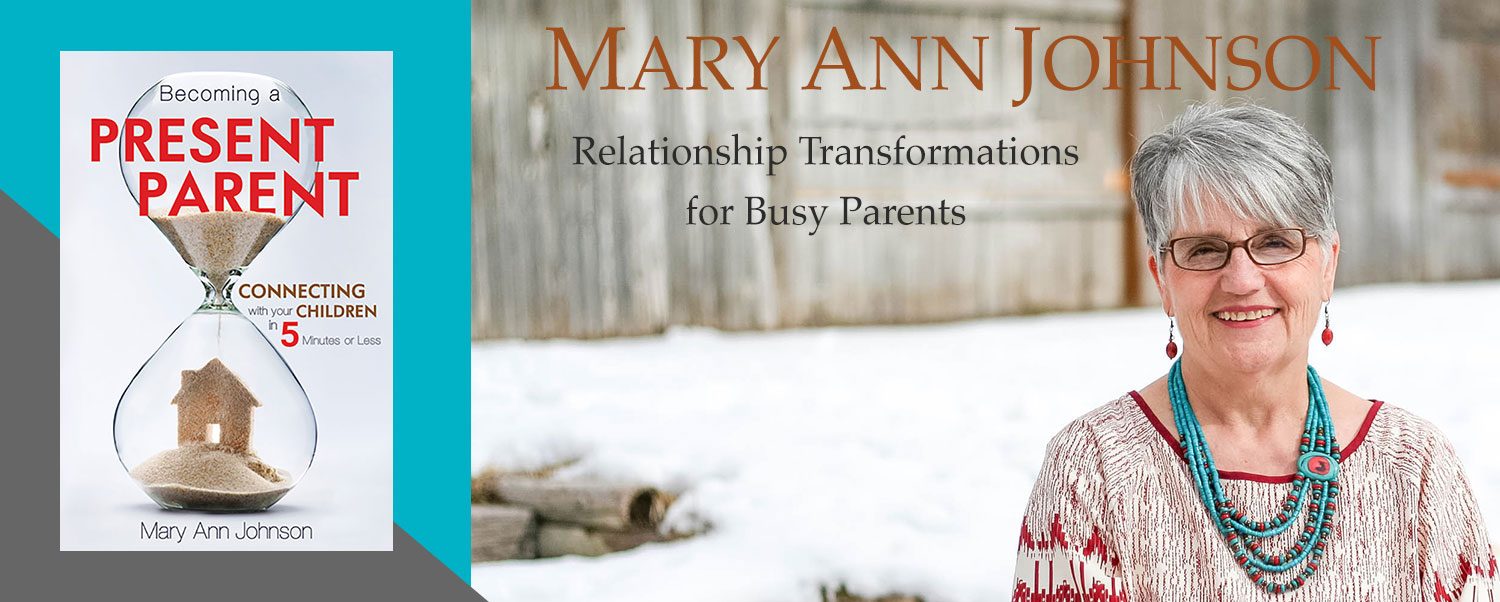


 Experiments to Improve Family Relationships
Experiments to Improve Family Relationships
 I am a
I am a 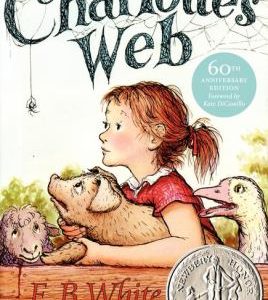
 Jodie was reading the book Charlott’s Web to her children. Frequently she would stop and ask a question. “What does manure mean?” “What does loft mean?” What does slop mean”? “What is a manure pile?” When the term manure pile came up again, later in the story, Jodie emphasized the term as she read. Then she asked, “Do you remember what manure pile means?” I heard, “Eweee, a pile of poop.” Then laughter.
Jodie was reading the book Charlott’s Web to her children. Frequently she would stop and ask a question. “What does manure mean?” “What does loft mean?” What does slop mean”? “What is a manure pile?” When the term manure pile came up again, later in the story, Jodie emphasized the term as she read. Then she asked, “Do you remember what manure pile means?” I heard, “Eweee, a pile of poop.” Then laughter.



